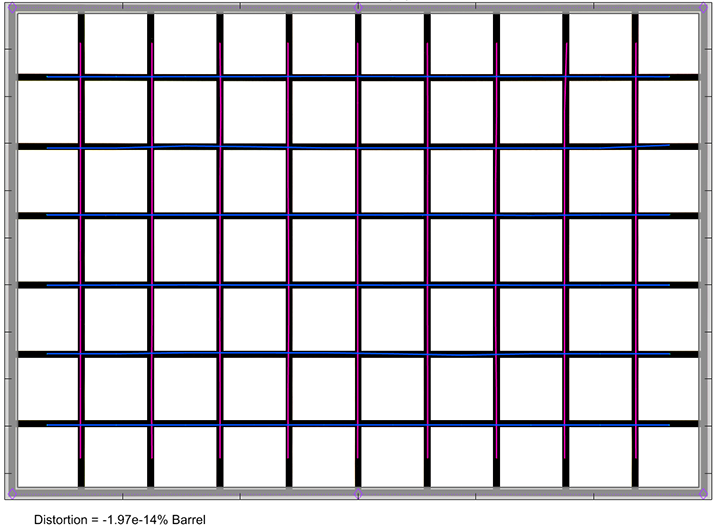Needless to say - it's a fully manual lens. Thus you set the aperture on the lens while (usually) setting the camera to aperture priority mode.
| Specifications |
|---|
| Optical construction | 6 elements in 5 groups |
| Number of aperture blades | 6 |
| min. focus distance | 1.20m (max. object magnification 1:?) |
| Dimensions | 65×68mm |
| Weight | 410g |
| Filter size | 55mm |
| Hood | barrel-shaped, screw-in, optional |
| Other features | - |
| Mount | Minolta MC/MD |
Distortions
Just like most lenses of this era, the Minolta MC Rokkor-PF 100mm f/2.5 is fully corrected with no image distortions to speak of.

Vignetting
Vignetting is quite well-controlled with a maximum light falloff of ~1.3EV (f-stops) at f/2.5. Stopping down to f/4 reduces the issue to a negligible degree already.

MTF (resolution @ 42mp on Sony Full Format)
The Minolta lens may have its strengths but sharpness isn't one of them - at least at f/2.5 and f/4. There's an overall softness, also related to low contrast, at these settings. Formally, the results are still "good" but are clearly lower than on other 100mm vintage lenses that we've tested. Stopping down to f/4 lifts the center quality to very good levels although the contrast is still not brilliant. There's a substantial gain in quality at f/5.6 and, more so, at f/8 where the lens is capable of producing a very sharp center and also a good to very good outer image field. As usual diffraction sets in at f/11 with a more pronounced impact at f/16 (not shown).
The field curvature is low. The centering quality of the tested sample was good.
Below is a simplified summary of the formal findings. The chart shows line widths per picture height (LW/PH) which can be taken as a measure of sharpness.
If you want to know more about the MTF50 figures, you may check out the corresponding Imatest Explanations

Chromatic Aberrations (CAs)
Lateral CAs vary along the aperture range with an average pixel width of around 0.8px at the image borders.

Bokeh
The Minolta may not be overly sharp at large aperture settings so what about the bokeh rendering?
Out-of-focus highlights are beautifully rendered with a smooth inner zone and no outlining. Typical for lenses of this time period, the more edgy aperture shape is already showing up at f/4. At the time, rounded aperture blades, which could mitigate the issue, were not invented/used yet.

When looking at the whole image field, the highlight discs don't stay circular outside of the image center but deteriorate to "cat eyes". However, the deterioration is still moderate. Stopping down to f/4 restores the "circular" shape at the expense of the edgier rendering.
The quality of the general blur in the focus transition zone is exceptionally smooth in the background (shown to the left below). The foreground blur (to the right) is a bit rougher with double edges.

Bokeh Fringing / LoCA
Boheh fringing/LoCA is an axial color fringing effect with purplish halos in front of the focus point and greenish beyond.
The Minolta doesn't use an APO design so the fringing is very pronounced at f/2.5. The LoCAs are substantially reduced at f/4 and mostly gone from f/5.6.
If you look closely, you may notice that the focus point moves to the rear when stopping down. This focus shift is called "Residual Spherical Aberration" or RSA. While noticeable, it isn't critical yet.
Verdict
The Minolta MC Rokkor-PF 100mm f/2.5 is a bit disappointing given Minolta's reputation during the 60s and 70s. At large aperture settings, it is very soft - both lacking contrast and resolution. Stopped down to f/5.6, this changes drastically and it's really good at f/8 and f/11. Image distortions are non-existent. Lateral CAs are quite low whereas axial CAs can probably be described as psychedelic. Shooting B&W may be a workaround here. A positive aspect is the smooth bokeh. Out-of-focus highlights are nicely rendered and the background blur is very smooth.
The build quality of the Rokkor is excellent. It uses an all-metal body with a silky smooth and dampened focus ring. The aperture ring feels somewhat coarse in comparison though.
It's obvious that the lens isn't a good match with today's high-megapixel sensors. There are certainly more obvious vintage lenses for photography both in terms of sheer capabilities - see e.g. our Nikkor P.C. 105mm f/2.5 review. We can, however, see the appeal that it can have for the video community. Ultimate sharpness is not always needed for videos and 4K video isn't overly challenging even for mediocre lenses anyway. The Minolta MC Rokkor-PF 100mm f/2.5 could just be the right thing if you are after a dreamy character in videos for instance. As such it may have its niche within a niche.